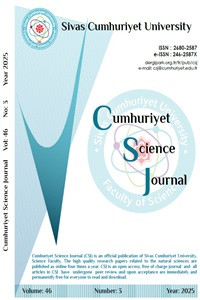Impact of Nuclear Deformation on GT Strength Distributions in Iron Isotopes within QRPA-Based Approaches
Abstract
Gamow-Teller (GT) transitions play a crucial role in nuclear structure studies and astrophysical modeling by providing insights into spin-isospin excitations. In this work, GT strength distributions—both B(GT)- and B(GT)+—are systematically calculated for selected iron isotopes within the proton-neutron Quasiparticle Random Phase Approximation (pn-QRPA) framework. The analysis incorporates both particle-hole and particle-particle channels and includes complementary approaches based on the schematic model and the Pyatov method. To assess the impact of nuclear shape, calculations are performed using different quadrupole deformation parameters derived from experimental and theoretical sources. The results demonstrate the sensitivity of GT strength to nuclear deformation and model choice. Comparisons with experimental data highlight the reliability of the deformed QRPA-based models, offering valuable input for astrophysical applications involving weak interaction processes.
Keywords
beta decay Gamow-Teller (GT) transitions proton-neutron Quasiparticle Random Phase Approximation schematic model Pyatov method
References
- [1] Heger A. et al., Presupernova evolution of rotating massive stars I. Numerical Method and Evolution of the Internal Stellar Structure, The Astrophysical Journal, 528 (2000) 368-396.
- [2] Bethe H. A., Supernova mechanisms, Reviews of Modern Physics, 62 (1990) 801–866.
- [3] Langanke K., Martínez-Pinedo G., Nuclear weak-interaction processes in stars, Reviews of Modern Physics, 75 (2003) 819–862.
- [4] Langanke K., Kolbe E., Dean D. J., Unblocking of Gamow-Teller strength in stellar electron capture on neutron-rich germanium isotopes, Phys. Rev. C, 63 (2001) 032801.
- [5] Ejiri, H., Nuclear spin isospin responses for low-energy neutrinos, Physics Reports, 338 (2000) 265–351.
- [6] Osterfeld, F., Nuclear spin and isospin excitations, Reviews of Modern Physics, 64 (1992) 491–558.
- [7] Cole A. L. et al., Gamow-Teller strengths and electron-capture rates for pf-shell nuclei of relevance for late stellar evolution, Physical Review C, 86 (2012) 015809.
- [8] El-Kateb, S. et al., Spin-isospin strength distributions for fp shell nuclei: Results for the 55Mn(n, p),56Fe(n, p), and 58Ni(n, p) reactions at 198 Mev, Physical Review C, 49 (1994) 3128-3136.
- [9] Wang, D. et al., The 52,54Cr(p, n)52,54Mn and 57,58Fe(p, n) 57,58Co Reactions at Ep = 120 Mev, Nucl. Phys. A, 480 (1988) 285-311.
- [10] Caurier E., Martínez-Pinedo G., Nowacki F., Poves A., Zuker A. P., The shell model as a unified view of nuclear structure, Reviews of Modern Physics, 77 (2005) 427-488.
- [11] Langanke K., Martínez-Pinedo G., Shell-model calculations of stellar weak-interaction rates: II. Weak rates for nuclei in the mass range A = 45–65 in supernovae environments, Nucl. Phys. A, 673 (2000) 481–508.
- [12] Nabi J.-U., Ground and excited states Gamow-Teller strength distributions of iron isotopes and associated capture rates for core-collapse simulations, Astrophysics and Space Science, 331 (2011) 537–554.
- [13] Mustonen, M. T., Engel, J., Global description of β- decay in even-even nuclei with the axially-deformed Skyrme finite-amplitude method, Phys. Rev. C, 93 (2016) 014304.
- [14] Ha E., Cheoun M.-K., Sagawa H., Colò G., Gamow–Teller strength distributions in ¹⁸O and in the well-deformed nuclei ²⁴,²⁶Mg by deformed QRPA, Phys. Rev. C, 110 (2024) 034617.
- [15] Shafer T., Engel J., Fröhlich C., McLaughlin G. C., Mumpower M., Beta decay of deformed r-process nuclei near A = 80 and A = 160, including odd-A and odd-odd nuclei, with the Skyrme finite- amplitude method, Phys. Rev. C , 94 (2016) 055802.
- [16] Salamov D.I., Kucukbursa A., Maras I., Aygor H.A., Babacan T., Bircan H., Calculation of the log(ft) values for the allowed Gamow–Teller transitions in deformed nuclei using the basis of Woods–Saxon wave functions, Acta Physica Slovaca, 53 (2003) 307–319.
- [17] Cakmak S., Nabi J.-U., Babacan T., Selam C., Study of Gamow–Teller transitions in isotopes of titanium within the quasi-particle random phase approximation, Astrophysics and Space Science, 352 (2014), 645–663.
- [18] Salamov D.I. et al., Proceedings of the Fifth Conference on Nuclear and Particle Physics (NUPPAC 05), (Cairo August 2006) 361.
- [19] Ikeda K., Collective Excitation of Unlike Pair States in Heavier Nuclei, Progress of Theoretical Physics, 31 (1964) 434–451.
- [20] Cakmak S., Effect of deformation, particle-hole and particle-particle interaction on Gamow-Teller Transitions of 76Ge, Cumhuriyet Science Journal, 41 (2020) 212-227.
- [21] Homma H., Bender E., Hirsch M., Muto K., Klapdor-Kleingrothaus H.V., Oda T., Systematic study of nuclear β decay, Phys. Rev. C, 54 (1996) 2972-2990.
- [22] Ring P., Schuck P., The Nuclear Many-Body Problem, 2nd ed., Berlin: Springer, (2004).
- [23] Raman S., Malarkey C.H., Milner W.T., Nestor C.W. Jr., Stelson P. H., Transition probability, B(E2)↑, from the ground to the first-excited 2+ state of even-even nuclides, At. Data Nucl. Data Tables, 36 (1987) 1-96.
- [24] Audi G., Wapstra A.H., Thibault C., The AME2003 atomic mass evaluation: (II). Tables, graphs and references, Nucl. Phys. A, 729 (2003) 337-676.
- [25] Cerkaski M., Dudek J., Szymanski Z., Andersson C. G., Leander G., Aberg S., Nilsson S. G. and Ragnarsson I., Search for the yrast traps in neutron deficient rare earth nuclei, Phys. Lett. B, 70 (1977) 9-13.
- [26] Dudek J., Nazarewicz W., Faessler A., Theoretical analysis of the single-particle states in the secondary minima of fissioning nuclei, Nucl. Phys. A, 412 (1984) 61-91.
- [27] National Nuclear Data Center, NuDat 3.0 Database. Available at: https://www.nndc.bnl.gov/nudat3/ (Accessed: August 3, 2025).
Details
| Primary Language | English |
|---|---|
| Subjects | Nuclear Physics, Plasma Physics; Fusion Plasmas; Electrical Discharges |
| Journal Section | Research Article |
| Authors | |
| Publication Date | September 30, 2025 |
| Submission Date | July 12, 2025 |
| Acceptance Date | September 14, 2025 |
| Published in Issue | Year 2025 Volume: 46 Issue: 3 |

